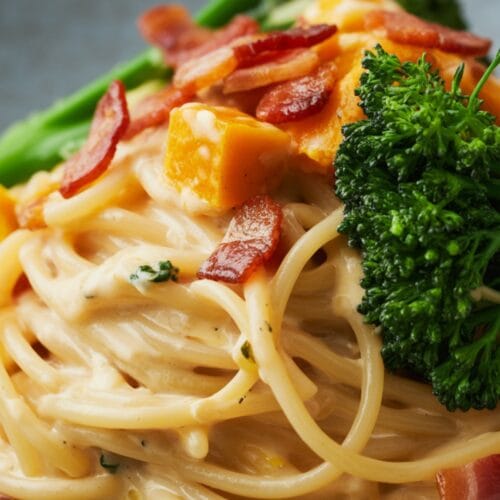
Winter Squash Carbonara with Broccoli Rabe
This golden-hued pasta transforms traditional carbonara with sweet winter squash puree and pleasantly bitter broccoli rabe. The dish maintains carbonara’s silky texture while creating a more complex, vegetable-forward flavor profile that’s perfect for cool weather dining.
Ingredients
- 1 medium butternut squash about 2 pounds, peeled, seeded, and cut into 1-inch cubes
- 3 tablespoons olive oil divided
- 1 teaspoon kosher salt plus more to taste
- ½ teaspoon freshly ground black pepper plus more to taste
- 1 bunch broccoli rabe tough ends trimmed, roughly chopped
- 4 ounces pancetta or bacon diced (omit for vegetarian version)
- 1 medium onion finely diced
- 4 cloves garlic minced
- 1 pound pasta fettuccine, spaghetti, or bucatini work well
- 2 large eggs at room temperature
- 1 large egg yolk at room temperature
- ¾ cup finely grated Pecorino Romano plus more for serving
- ½ cup finely grated Parmesan
- ¼ teaspoon nutmeg freshly grated if possible
- Red pepper flakes to taste (optional)
Instructions
- Roast the squash: Preheat your oven to 425°F. Toss squash cubes with 2 tablespoons olive oil, salt, and pepper on a baking sheet. Spread in a single layer and roast for 25-30 minutes until very tender and caramelized at the edges, stirring halfway through.
- Prepare the pasta water: Bring a large pot of heavily salted water to a boil. The water should taste like the sea – this is crucial for properly seasoning the pasta.
- Blanch the broccoli rabe: Add the chopped broccoli rabe to the boiling water and cook for 2 minutes until bright green and slightly tender. Using tongs or a slotted spoon, transfer to a colander (keep the water boiling for your pasta). Rinse briefly with cold water to stop cooking, then drain well.
- Cook the pancetta: In a large skillet over medium heat, cook the diced pancetta until crispy, about 5-7 minutes. Remove with a slotted spoon to a paper towel-lined plate, leaving the fat in the pan.
- Sauté the aromatics: Add remaining tablespoon of olive oil to the pancetta fat. Add onion and cook until softened, about 4 minutes. Add garlic and cook 1 minute more until fragrant. Add the blanched broccoli rabe and sauté for 2-3 minutes until tender. Season with salt and pepper. Remove from heat and set aside.
- Cook the pasta: Add pasta to the boiling water and cook until al dente according to package directions. Reserve 1½ cups of pasta water before draining.
- Blend the squash: While pasta cooks, transfer roasted squash to a blender or food processor. Add ½ cup of the reserved pasta water and blend until very smooth. The consistency should be like a thick sauce – add more pasta water if needed.
- Prepare the egg mixture: In a medium bowl, whisk together eggs, egg yolk, both cheeses, nutmeg, and ¼ teaspoon each salt and pepper until well combined.
- Combine everything: Return the drained pasta to its pot over low heat. Quickly add the squash puree and ¼ cup pasta water, tossing continuously. Remove from heat completely, then immediately add the egg mixture, continuing to toss vigorously to create a creamy sauce (the residual heat will cook the eggs). If sauce seems too thick, add more reserved pasta water a tablespoon at a time.
- Finish the dish: Fold in the broccoli rabe mixture and crispy pancetta. Taste and adjust seasoning with salt and pepper. Serve immediately, topped with additional grated cheese and red pepper flakes if desired.
Notes
- For the silkiest sauce, make sure your eggs are truly at room temperature. Cold eggs are more likely to scramble than create a smooth sauce.
- Don’t skip blanching the broccoli rabe – this removes some of its bitterness and ensures it’s perfectly tender in the final dish.
- The squash puree can be made a day ahead and refrigerated. Just warm it slightly before adding to the pasta.
- For a vegetarian version, omit the pancetta and use 2 tablespoons of butter plus 1 tablespoon olive oil to sauté the aromatics.
- To make this gluten-free, simply substitute your favorite gluten-free pasta – the sauce works beautifully with any shape.